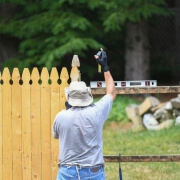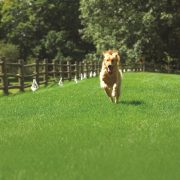Fencing For Dogs Who Escape
Fencing for dogs – Which Fence Is Best?
Here you are finding yourself researching about fencing for dogs. I am guessing your canine companion is one that is a great escape artist! I have one too and not one who jumps over a fence but one who finds the smallest gap and squeezes himself out or it maybe you have a high energy dog who just loves attention from any passing people or other dogs, whatever breed you own, a dog is always on the lookout for freedom to roam.
Frequent escapes create a number of worries for you as a pet owner:
- Theft.
- Become a bait dog.
- Poisoned.
- Even shot for chasing livestock.
- Picked up by the local dog warden (which costs you).
- Be at risk of injury or hit by a moving vehicle.
All of these worries are real today! Dogs do not see these dangers, they escape because they can and often if left for long periods of time, because of boredom.
There is a simple solution to this issue of fencing for dogs and that is for an invisible or hidden fence. Whereas a static fence:
- A dog can jump over.
- Dig its way out underneath.
- Chew through in a bid for adventure or someone to be with.
Interestingly, people often say a dog can run through the wired or wireless system – however…read on and you will see why this is and why DogFence systems do not pose this issue.
Wired or Wireless Fencing For Dogs
Sadly, there has been much stigma about electronic fences and shock collars but the collars available today are far removed from the collars available 40 years ago. Today’s systems have improved massively in terms of stimulation levels, size of receiver collars, training etc. People are concerned that these fences may be illegal. All our DogFence systems are 100% legal. Of course, our legal dog fences come with patented fail-safe FM radio frequency technology. Unlike the AM frequency dog fencing systems, it will not fail or activate accidentally.
Wireless dog fence
Most dog fences are wired but wireless systems are available but are often not as effective due to the constraints regarding lay of the land etc. With the wireless installations, there can be issues with undulating terrain, trees, and building and these types of pet fence are highly prone to false activation. Whilst they may be quick to install, sadly the end result can be confusion for the dog. As with any Pet Training protocol it is best to take time. Taking a day or so to install a wired fence will give your dog more freedom. If your dog is happy and safe then this will also give you peace of mind as well.
Of course, wireless dog fences have a few advantages over their wooden or chain-linked counterparts. Many electric dog fences require few tools to install and can be set up in an afternoon. Unlike a traditional gate, the layout of many invisible dog fences isn’t as restricted by the topography of your garden. Using an invisible fence does not obstruct your view, it is ideal for creating a space for your dog. A wireless dog fence allows you to increase the range of your boundary area. You can link additional receiver collars to increase the range of the signal.
What is an Invisible Dog Fence & How Does It Work?
- An FM radio signal created a virtual fence. Dog Fence uses the Safelink patented FM digital technology.
- 15 times faster than AM radio signal fence systems.
- An invisible fence can cover a large area (at a fraction of the cost of traditional fencing).
- The radio signal transmits to a collar worn by the pet.
- A zone before the boundary triggers a high pitched beep from the collar, to warn your pet.
- At the boundary, your pet gets a warning beep and small static impulse, through the collar.
- Temporary training flags are installed to give the pet a visual
- Through training, the pet learns to retreat to a safe area.
- Maximum protection against false activation.
- If a correctly trained a dog cannot run out of an FM radio signal.
- 2-5 days training programme for your pet.
- Suitable for dogs over 12 weeks and cats over 16 weeks.
- Discomfort from the impulse, experienced by your pet, occurs mainly during the initial training. It feels no worse than an annual vaccination. The stimulation cannot compare to the pain of being hit by a car!
- Costs a fraction of the price of installing a traditional fence.
Conclusion
All things considered, the best fencing is a hidden containment fence, one which transmits over FM frequency. After all, we are pet lovers and the importance of our pet’s safety should not be underestimated. Pet shelter organisations do require you to have secure fencing in place before approval of adoption too. With other types of fencing for dogs, a pet has the means to escape. You want peace of mind that the fencing you choose is secure enough to keep your pet safe.
To conclude, hidden legal dog fences are the best choice, due to the following factors:
- They are highly effective at pet containment.
- The fence is invisible and does not obstruct your view.
- A cost-effective solution that allows freedom for a safer, happier, independent pet.
- An easier life for you the pet owner having less worry.
- They are professionally installed.
DogFence Ltd offers a pet training programme as part of its installation service. This is designed to minimise the static shocks, to your pet, by ensuring can teach your pet it’s new boundaries. So don’t wait, get in touch with our friendly team here at Dog Fence today for an informal chat about fencing for dogs to suit yours & your pet’s needs.
Related posts:
Electric Dog Fences Weighing Up The Pro’s & Con’s
Electric Dog Fences Are The Cruel
8 Top Tips To Stop Dogs From Escaping











